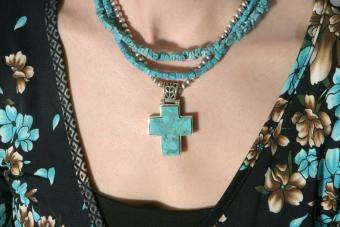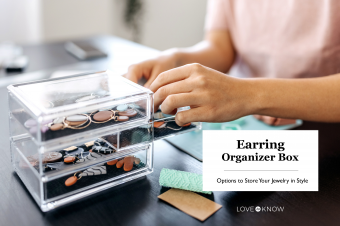
Pearls have been prized jewels for thousands of years. Unfortunately, their rarity made them so costly that only the wealthy could afford these gleaming gems. Thanks to the development of cultivation techniques, however, beautiful, genuine pearls are now accessible to most budgets.
How Freshwater Pearls are Formed
Living organisms called mollusks create freshwater pearls. While oysters generally make saltwater pearls, mussels usually produce freshwater pearls. Natural pearls are formed when an irritant, perhaps a grain of sand, enters the mussel's shell. If the mussel cannot rid itself of the foreign object, it coats it with nacre in an effort to make it less irritating, resulting in a pearl. The mollusk's mantle tissue secretes the nacre, which is the same substance the mollusk uses to coat its shell. Nacre is commonly called mother of pearl when taken from the inside of a shell. It can take two or three years and many coats of nacre before a good sized pearl is formed.
Until the 20th century, pearl divers had to search through many mollusks in order to find a single natural pearl of good quality, but at the turn of the century, Japanese pearl farmer Kokichi Mikimoto developed the process for making cultured pearls. Cultured pearls result when an irritant is purposefully introduced in the mussel in order to create a pearl. Mantle tissue from another mussel is often used as the irritant. Today most of the pearls on the market are cultured pearls.
Biwa Pearls
The first cultured freshwater pearls came from Japan's largest lake, Lake Biwa, and are referred to as Biwa pearls. Over the last decades, pollution and over farming have caused most of the mussels in the lake to die, and only a few pearls today are harvested from Lake Biwa. Many sources refer to all freshwater pearls as Biwa pearls; however, that name should only be applied to pearls that are from Lake Biwa.
Places to purchase Biwa pearls:
- Yvel: In 1998, owners Orna and Isaac Levy "managed to buy a very large quantity of the Biwa coin pearls..." Some of the Yvel jewelry designs feature only Biwa pearls, while others use a combination of Biwa pearls and other coin pearls bought various freshwater pearl farms. You can find necklaces, drop earrings and even coin pearl earrings in the Biwa Collection.
- eBay: You can occasionally find "authentic Biwa pearl jewelry" for sale on eBay. Many of these pieces are also vintage. Be sure to check for documentation of authenticity before buying.
- Alibaba: This website is known as one of the world's largest online trade sites. Resellers, buyers and suppliers from around the world can be found here. A word search for "authentic Biwa pearl jewelry" usually pulls up a few vintage pieces. You may need to visit regularly before you find the exact piece you want.
- Bizrate: This is a great search engine for finding truly one-of-a-kind Biwa pearl creations. A typical search will pull up some master designer pieces that are currently being resold along with other vintage pieces.
Chinese Pearls
Most of the modern day freshwater pearls sold hail from China. As early as 500 AD, the Chinese practiced a form of pearl culturing that created Buddha imaged pearls. These pearls were created by placing tiny lead Buddha sculptures into mussels that were coated with the mussel's natural excretion, nacre (Mother of Pearl). This process resulted in a beautiful, pearly Buddha image. However it wasn't until the 20th century that the Chinese pearl farms actually began producing cultured pearls. The first attempts were less than desirable with poor quality of misshapen rice pearls being offered during the early 1980s. A decade later, the Chinese developed a new cultivation technique that produced a rounder and smoother freshwater cultured pearl. The less expensive Chinese freshwater pearls are similar in appearance to more costly Japanese saltwater pearls. If you aren't interested in making an investment but simply want to own a great-looking string of beautiful, genuine pearls, then Chinese freshwater pearls are just the ticket.
- DHgate.com: You can find a few thousand choices of wholesale freshwater pearl necklaces that include strands, pendants and other necklace styles. If you're looking for other jewelry pieces, you have a choice of pearl rings, bracelets, earrings and pins.
- Topearl: Specializing in Chinese culture pearls, this company offers a wide selection of all types of pearls from coin to rice or simple round pearls. You can find strand, necklace, ring, earring and bracelet styles for any occasion.
- Oriental Pearls: Offering one of the largest and widest selections of various colored pearls, Oriental Pearls has any style or design of jewelry you can think of at wholesale prices.
- You Pearl: This cultured pearl manufacturer and wholesaler features freshwater pearl jewelry available in necklaces, bracelets, strands, rings and earrings. You can also buy loose beads if you wish to string your own strand of pearls.
- Pearl Distributors: If you're seeking a strands of pearls, then you may find the Freshwater Orient Necklace Collection a perfect addition to your jewelry stash. Choose from white, lavender, peach or multi-colored strands.
Judging Freshwater Pearls
When assessing freshwater pearls, there are a number of qualities to consider, such as color, luster, surface quality, shape, size and weight.
- Freshwater pearls are prized for their variety in color, including off-white, yellow, peach, pink and lavender; however, white is still the most popular.
- Luster is a difficult trait to describe and is best learned by looking at pearls of varying quality. You can assess luster by examining the pearl's shininess, the amount of light reflected and the appearance of depth in a pearl. Better quality pearls have more luster.
- Pearls with good surface quality are smooth with few blemishes.
- The shape of the pearl is an important factor in determining its value. Most freshwater pearls are not perfectly round, so the rounder the shape, the better the pearl.
- If the quality of pearls is comparable, the larger, heavier pearl is worth more; yet, a good quality small pearl is worth more than a large pearl of poor quality.
If you keep these factors in mind as you choose freshwater pearls, you'll end up with jewelry you'll love for decades to come.







